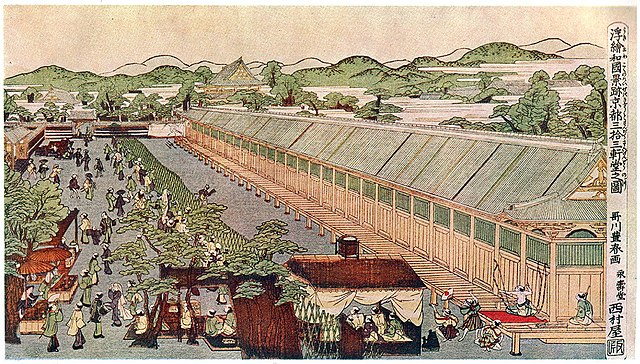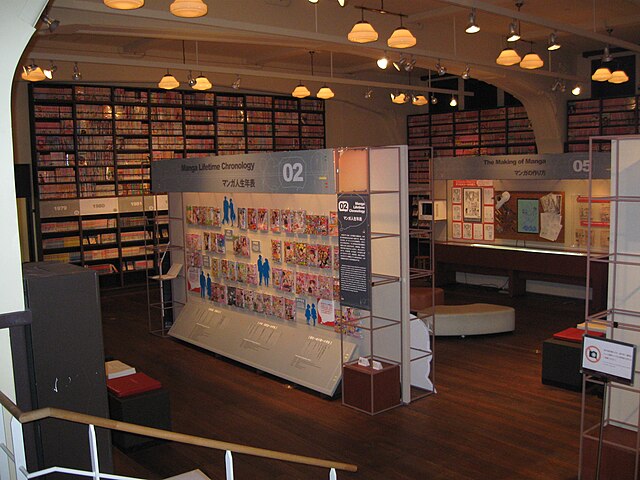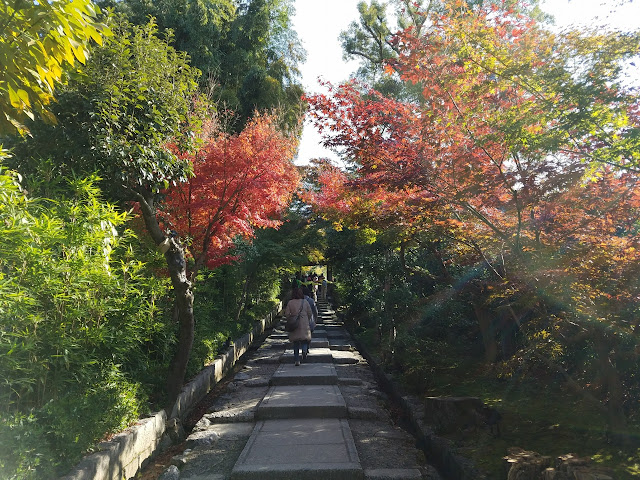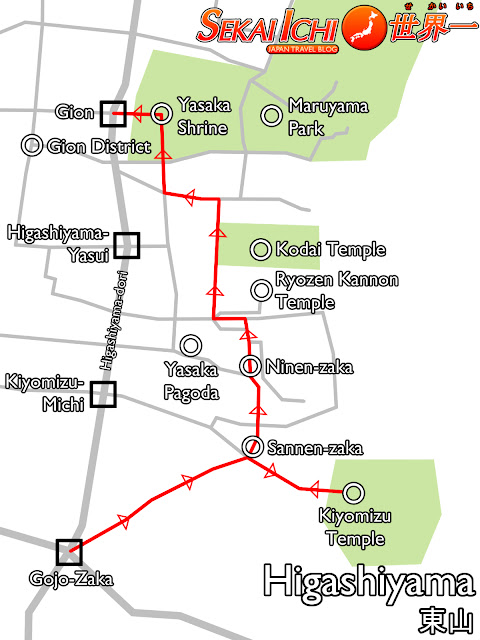Rengeo-in (蓮華王院, Rengeō-in, lit. 'Temple of the Lotus King') is the official name of a particular Buddhist temple in southeastern Kyoto. It is better known, however, as Sanjusangen-do (三十三間堂, Sanjūsangen-dō, lit. 'thirty-three-span hall'), named after the length of its main hall, measured as 33 spans between pillars. (Its actual length is 120 meters, or 393 feet.) Visitors to the temple may walk through the length of the hall and back around, passing over a thousand gilded Buddhist statues along the way.
Which do you think gets across the length of the building better: the straight angle shot at the top of this article, or this panorama shot here? To view this picture in full size, click here.
The temple's main claim to fame lies within its halls, and I'll get to that in due time, but there's more to it than that. In the temple grounds, the main hall stands side-by-side with a wide courtyard, in which there are a few landscaped ponds like this.
This is the same pond, from the other side.
The main hall is made of unpainted wood, but other vermillion-hued buildings inject some colour into the complex, such as the outer walls and this bell tower.
Photography is not allowed inside the temple halls, so sadly I do not have my own pictures of its many statues. If you can navigate the temple's website (linked at the end of this article), which is only offered in Japanese, there are a few pictures to give you an idea. On top of that, there are a small number of pictures available from Wikimedia Commons, so I will be using them to illustrate my descriptions.
 |
| By Bamse [CC BY-SA 3.0 or GFDL], from Wikimedia Commons |
The actual number of arms in depictions of the Thousand-Armed Kannon varies; here it is forty-two, including its two original arms. Multiplying the forty extra arms by the 25 planes of existence in Buddhist belief will tally up to a thousand. (Then again, everything I've been able to Google on the subject tells me there are 31 planes of existence, so I don't know... but to be fair, you try sculpting a statue with a thousand arms.) The figure itself is 3.34 metres (11 feet) tall, and the entire statue, including the base and back pieces, is 7 metres (23 feet) tall.
 |
| By Tamamura Kozaburo ([1]) [Public domain], via Wikimedia Commons |
_Sanjusangendo.jpg/322px-Twenty-Eight_Attendants_(Taishakuten)_Sanjusangendo.jpg) |
| By Nara National Museum 奈良帝室博物館 (Showa 8 - 1933) (1933 奈良帝室博物館 volume on Japanese sculpture) [Public domain], via Wikimedia Commons |
Finally, this is a map of the Keihan train line, which I took at their nearby Shichijo station. The cute archer girl in the lower-right corner represents the Toshiya (通し矢, Tōshi-ya, lit. 'target-hitting arrows') archery competition, which I will describe below.
 |
| By 哥川豊春 Toyoharu Utagawa (From here) [Public domain], via Wikimedia Commons |
 |
| No machine-readable author provided. Peter 111 assumed (based on copyright claims). [Public domain], via Wikimedia Commons |
Hours: Open 8:00 AM to 5:00 PM, or 9:00 AM to 4:00 PM from 16 November to 31 March. Admission ends 30 minutes before closing time. No regular closing days.
Costs: ¥600.
Address: 657 Sanjūsangen-dō Mawari, Higashiyama-ku, Kyōto-shi, Kyōto-fu 〒605-0941
Access: From Kyoto Station, take bus #86 (stand D2), #88 (D23), #100 (D1), #110 (D1), #206 (D2), or #208 (D2) and get off at the Hakubutsukan Sanjusangendo-mae stop (10 minutes, ¥230).
Kiyomizu-dera can also be reached on foot in 5 minutes from Shichijo Station, on the Keihan Main line (KH), or in 20 minutes from Kyoto Station.
Website: (Japanese)






































.jpg/640px-Big_buddha_(4180724031).jpg)



